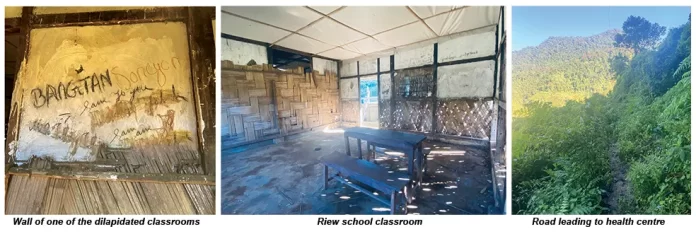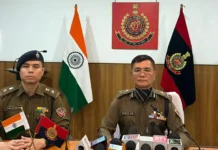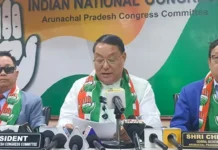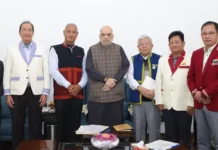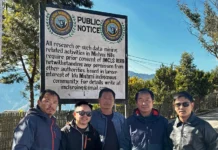Siang Multipurpose Project
[ Tongam Rina ]
Riew village, located in Siang district, is one of the epicentres of the latest wave of protests against the state government’s arbitrary decision to deploy hundreds of central and state armed police for a pre-feasibility study for the proposed 11,000 mw Siang multipurpose project.
The village is just a short distance from the magnificent Siang river, which, for now, stands as a quiet witness to the present unrest, uncertainty, and anxiety of its people.
The main road leading to the village is lined with plucked oranges, ready for wholesale buyers from Assam.
The mostly-women farmers won’t sell them to passersby like me, but they will give a few for free as compensation for not selling them to individuals. There are lines of trucks waiting to pick them up while the farmers hurry back with their huge egins – traditional baskets – from the nearby orchards.
As you reach the village, the Adi traditional homes and granaries stand as a testament to the region’s rich tribal architecture. Almost two kilometres away from the centre of the village is Riew primary school. Like many schools in the state, the school building, with its football ground surrounded by tall mountains, is in a state of extreme dilapidation. Abandoned due to lack of teachers and facilities, the school is a stark example of government apathy, forcing villagers to send their children to the nearest private schools.
Riew villagers are mostly affluent farmers of cash and traditional crops, so they can afford to send their children away. However, this comes at a cost, felt only by parents and children who are forced to live away from home due to the state’s failure to provide free education. Despairing at the lack of help from the state to provide basic infrastructure, the community has already repaired the school multiple times over the years. Eventually, the villagers had to send the children away for better education, far from the village, because there was no effort from the state.
The state’s negligence became evident in December when the district administration asked the villagers to repair the primary school on a self-help basis, so the Central Armed Police Force (CAPF) could oversee the pre-feasibility study for the multipurpose project of national importance. The gaon buras (village heads), appointed by the government, and the village committee, appointed by the villagers, say that a police officer came to the village to direct them to repair the school without explaining why a government-abandoned school should be repaired. They say that initially, they did not realise the reason, and they faced the ire of the villagers when it became public why the repair was needed. They even filed a police complaint against the administration for misleading them. The complaint was subsequently withdrawn, but they feel the state kept the affairs of their own area hidden from them. The anger and hurt are palpable at the very idea of bringing in armed police to force them into something they had no idea about.
The school remains in disrepair. Most of the classrooms are falling apart, and there are very few benches and desks. Graffiti on the walls, scrawled in the Roman script, includes English, Hindi, and Assamese swear words – an unpleasant sight and read. In one of the walls, someone has written ‘Bangtan Sonyeondan’, the widely popular K-pop band known as BTS worldwide.
Back in the village, it’s windy, and there are almost no small children, except a few being carried by their aged grandparents while we conduct interviews. The villagers count the names of those who are part of the state-organised coordination committee for the proposed project. It has very few names, they say, and with the proposal to send in forces, it will be even fewer. The state has united the villagers for a cause: against militarisation and coercion.
With the busy paddy season over and oranges ready for buyers, it would have been a few weeks of rest for the villagers to welcome the festive season. However, the government had other plans, disturbing the peace and well-deserved rest of the farmers and families who gather for the New Year celebrations.
The situation is similar in Parong village, another epicentre of protests against militarisation, which is almost an hour away from Riew. The school in Parong-II is defunct due to lack of facilities while Parong-I, a primary school has just one teacher. These two villages are well-connected by roads, but other government facilities are starkly missing. The villagers refer to the lack of facilities every time they talk about the government’s mission to construct a mega hydropower project, conveniently dubbing it a “multipurpose project” and asking why it has prioritised that while denying basic necessities like education and healthcare to thousands of villagers in the district.
Like many places in the state, health facility is next to nil in Riew. However, there are hoardings bigger than the facilities themselves, typical of a government that has become an event management company – advertising grandly but delivering far less.
The health sub-centre in Riew rarely opens, say the villagers, but the Ayushman Bharat signboard remains shining and colourful. There is no proper road leading to the sub-centre or the school, which are adjacent to each other. Even in this dry winter season, the small path leading to the sub-centre the school is slippery and muddy.
None of these issues seem to be priorities for the Pema Khandu government, which seems more focused on ensuring that the study for the multipurpose project is forcibly carried out through intimidation and militarisation.
When basic facilities are lacking, they blame the weather or the pandemic, which occurred five years ago. These villages need basic minimum facilities because they are border areas, even if they do not fall under the official description of a border district. The much-talked-about Vibrant Border Village scheme of the Centre, pushed by the state, and the Border Area Development Programme come across as a cruel joke – schemes that seem designed only for funds to be pocketed by a few.
In Siang district, Kaying and Payum circles are under the BADP. Payum still lacks road connectivity. It’s a good time to rethink why there is such a stark difference in facilities in border districts.
While there seems to be no discussion on basic facilities, the government has managed to push people into uncertainty. The protests in Siang villages began in August this year, after the state decided to conduct studies for the proposed project sites without informing the people, let alone seeking their consent. This led to the first in a series of protests spread over the months, which continued through December. It appears that unless the government takes a softer stance, the villagers will not budge from where they stand today: against militarisation and the project itself. For now, hurt by the forceful attempts of the government to militarise a peaceful border area devoid of facilities, the villagers seem unwilling to talk, even if the government takes hundreds of steps back. All these villages want is their consent and the right to decide about their land and homes, with opposition to militarisation being non-negotiable – something the hostile government is clearly not ready to acknowledge.
For many patriarchal Arunachali leaders, the concept of consent might be difficult to grasp, as privilege can often be blinding. It’s a weapon used on the powerless and the weak, and when the suppressed revolt, it can be hard to accept, leading to violence of all forms.
The Siang river, the very core of Adi society and culture, may be a good place to start a conversation about consent and respect for the right of the people to make informed choices. One can only ignore this at their own peril, unless they are ready to compromise on peace in this sensitive border region, zealously guarded by people proud of their land, their dere (community hall), where all important decisions are taken collectively by the villagers at the call of village elders, and where there is space for discussion and mutual respect.
Overstepping and undermining these traditions would mean bigger protests than what the state witnessed in the last couple of months, and more recently in December.
Should the Indian state ignore all of these and use coercion and militarisation as proposed? No, it can’t afford it – not for now.

